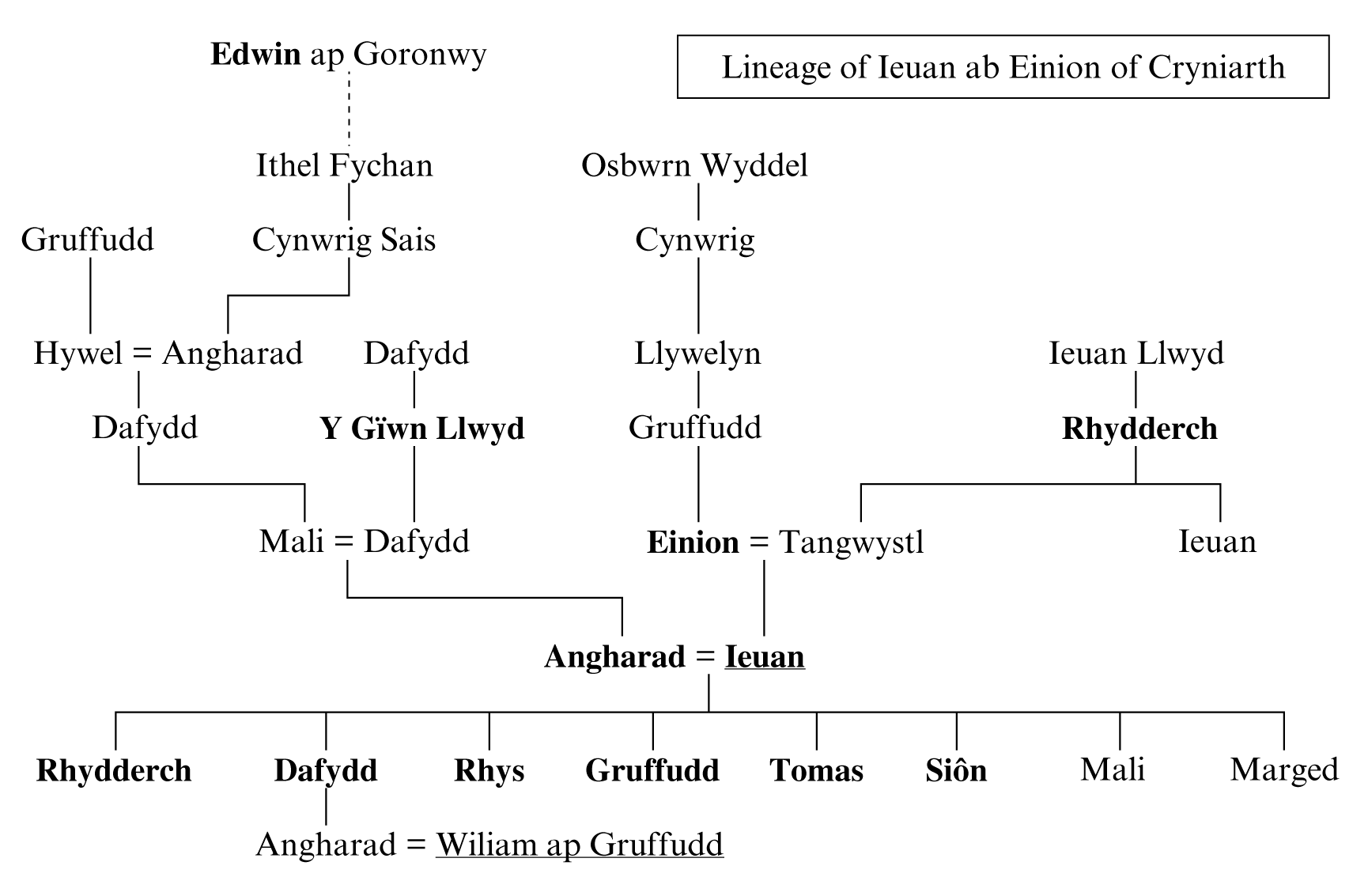Poem 48, composed for Ieuan ab Einion of Cryniarth in the parish of Llandrillo in Edeirnion, is the only surviving poem to him. Guto praises Ieuan, his wife, Angharad daughter of Dafydd, and their eight children. Lewys Môn composed an elegy for his grand-daughter, another Angharad daughter of Dafydd (GLM poem XLIV), who married one of Guto’s patrons, William ap Gruffudd of Cochwillan.
Lineage
The genealogical table below is based on WG1 ‘Bleddyn ap Cynfyn’ 21, ‘Edwin’ 1, 10, 12, 14, 15, ‘Osbwrn’ 1, 2. Those named in Guto’s poem for Ieuan are shown in bold print, and the names of his patrons are underlined.

Lineage of Ieuan ab Einion of Cryniarth
As is shown, Ieuan was a nephew of the famous poet, Ieuan ap Rhydderch (see GIRh).
His career
Ieuan ab Einion has been described by Carr (1961–4: 292) as one of the leading men of Meirionnydd after the uprising of Owain Glyndŵr. He is praised in particular by Guto for his cywirdeb ‘integrity’ (48.1, 22) in seeking to promote peace and to control lawless elements in a period of great disturbance and anarchy. The first official record concerning him dates to 1399, when he was one of the escheators of Meirionnydd. In 1414 he was one of the farmers of the royal interests in Edeirnion, and in 1432 he was again escheator and still held the office three years later (Carr 1961–4: 293).
Although Ieuan lived in Cryniarth, he was also related to the family of Corsygedol, Ardudwy, and this link with Gwynedd is mentioned several times by Guto, as by other poets addressing the same family (see 48.8n). By marrying Angharad daughter of Dafydd, heiress of Hendwr in the same parish, he added that home to his possessions. It appears that Ieuan was advanced in years when this poem was sung to him, for he is referred to as Noe hen ‘aged Noah’ (62), and he perhaps died in the 1450s (further on his dates, see poem 48).
Little is known of his wife Angharad beyond the poem. Note, however, that Guto has high praise for the lineage of this woman, who was uwch neu gyfuwch â’i gŵr ‘equal or superior to her husband’ (48.10), and that he attributes to her a strong and influential character as she did not allow Ieuan to take the property of the innocent (48.17–18). Of the couple’s children the most illustrious by far was Dafydd, and he fought with three of his brothers, Gruffudd, Tomas and Siôn, for the Lancastrian cause in the Wars of the Roses (see 47n, 52n). The six sons are praised highly (although nothing much is said about Gruffudd, 52) but the two daughters are not named and are not praised except indirectly by saying that they are, like the other siblings, teg ‘fair’ (61) and cyweithas ‘genial’ (63).
As Carr (1961–4: 187–8, 299) has observed, Edeirinion was in a unique situation in the northern part of the Principality following the settlement of Edward I, for in 1284, in exchange for surrendering to him after the death of Llywelyn ap Gruffudd, Edward allowed the lords of Edeirnion to retain their hereditary entitlements and privileges. Consequently, the leaders of this region were the last Welsh lords of royal blood to rule in the land of their ancestors, and they continued thus for a further three centuries, although they gradually faded out, becoming small squires and gentlemen farmers. Nonetheless, there was clearly sufficient energy and valour left in the family of Ieuan ab Einion when Guto addressed them.
Bibliography
Carr, A.D. (1961–4), ‘The Barons of Edeyrnion, 1282–1485’, Cylchg CHSFeir 4: 187–93, 289–301





